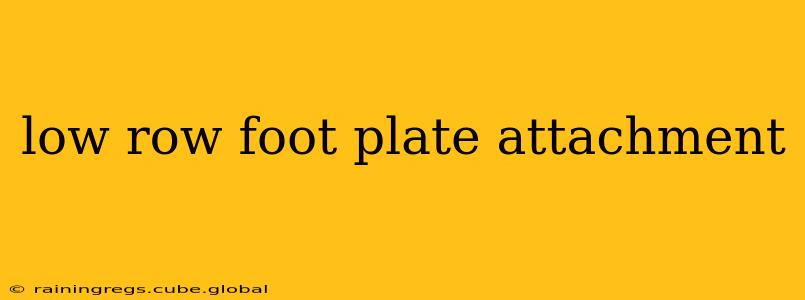The low row foot plate is a staple piece of equipment in many gyms, offering a fantastic way to target your back muscles effectively. But maximizing its benefits requires understanding proper form and technique. This comprehensive guide will delve into everything you need to know about using a low row foot plate attachment, from choosing the right weight to avoiding common mistakes.
What is a Low Row Foot Plate Attachment?
A low row foot plate attachment is a piece of gym equipment designed to be used with a cable machine. It typically consists of a footrest platform that securely holds your feet while you perform the low row exercise. This setup allows for a stable base, enabling you to focus on controlled movements and maximizing the effectiveness of the exercise. The key difference from other rowing variations lies in the foot placement and the resulting engagement of different back muscles.
How to Use a Low Row Foot Plate Attachment: A Step-by-Step Guide
-
Adjust the Seat Height: Ensure the seat is adjusted so your knees are slightly bent when your feet are flat on the footrest. Your torso should be roughly parallel to the ground.
-
Secure Your Feet: Firmly place your feet on the footrest, ensuring a stable base.
-
Grip the Handle: Choose an overhand or underhand grip, depending on your preference and what you're targeting. Overhand grips tend to emphasize the latissimus dorsi (lats), while underhand grips can engage the biceps more.
-
Start Position: Extend your arms fully, keeping a slight bend in your elbows. Your body should be straight, engaging your core for stability.
-
Pull the Handle: Pull the handle towards your abdomen, keeping your back straight and squeezing your shoulder blades together. Focus on controlled movement rather than momentum.
-
Controlled Release: Slowly return to the starting position, resisting the weight. Avoid letting the weight drop.
-
Repetitions: Aim for 8-12 repetitions for 3-4 sets. Adjust the weight accordingly to maintain good form throughout the exercise.
What Muscles Does the Low Row Foot Plate Work?
The low row primarily targets the muscles of your back, including:
- Latissimus Dorsi (Lats): These large, superficial back muscles are responsible for the majority of the pulling motion during the low row.
- Rhomboids: Located between your shoulder blades, the rhomboids help stabilize your shoulder blades and assist in pulling them together.
- Trapezius (Traps): These muscles run from the base of your neck to your mid-back and help with pulling and shoulder stabilization.
- Posterior Deltoids: These muscles in the rear of your shoulders are activated to help control the movement and stabilize the shoulder joint.
What are the Benefits of Using a Low Row Foot Plate Attachment?
- Improved Posture: Strengthening your back muscles helps improve posture and reduces the risk of back pain.
- Increased Strength: The low row effectively builds strength in your back and arms.
- Enhanced Athletic Performance: Stronger back muscles are crucial for many sports and activities, improving overall athleticism.
- Reduced Risk of Injury: Correctly performed low rows strengthen stabilizing muscles, protecting your back from injury.
Common Mistakes to Avoid When Using a Low Row Foot Plate
- Arching Your Back: Maintain a straight back throughout the exercise to avoid injury.
- Using Momentum: Focus on controlled movements to maximize muscle activation and minimize the risk of injury.
- Not Engaging Your Core: Engaging your core provides stability and improves the effectiveness of the exercise.
- Using Excessive Weight: Start with a lighter weight to master the form before progressively increasing the weight.
What is the difference between a low row and a seated row?
The primary difference lies in the position of your body. A seated row typically uses a bench with a back support, allowing for a more upright torso. The low row, with its foot plate, places you in a more reclined position, emphasizing different muscle groups and allowing for a greater range of motion. This difference in posture alters muscle activation patterns and can affect the intensity and focus of the exercise.
Are there any variations of the low row foot plate exercise?
Yes, several variations exist, such as altering your grip (overhand, underhand, neutral), changing the width of your grip, or using a different type of handle. These variations allow you to target specific muscles within the back and adjust the intensity of the exercise.
How often should I do low rows?
It’s generally recommended to incorporate low rows into your workout routine 2-3 times per week, allowing for adequate rest between sessions for muscle recovery.
By following this guide, you can harness the full potential of the low row foot plate attachment and effectively build a stronger, more resilient back. Remember, proper form and consistent effort are key to maximizing your results and avoiding injuries.
